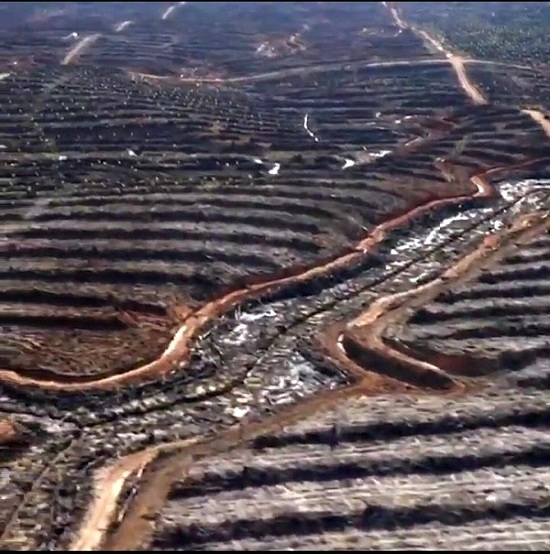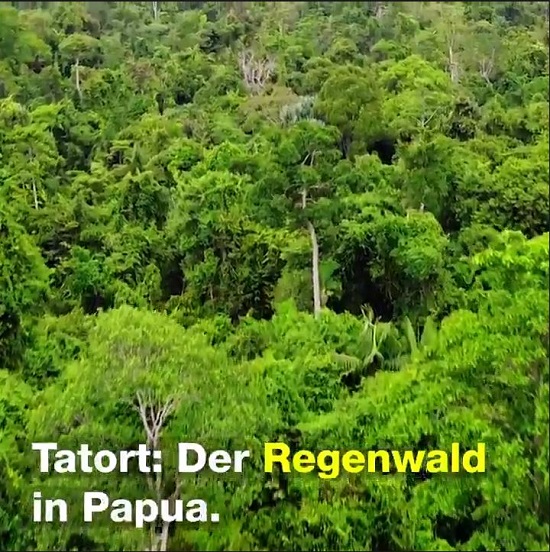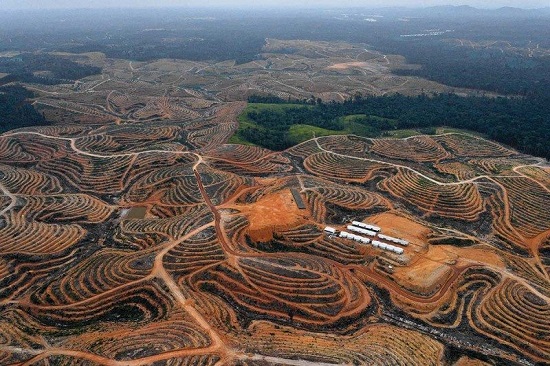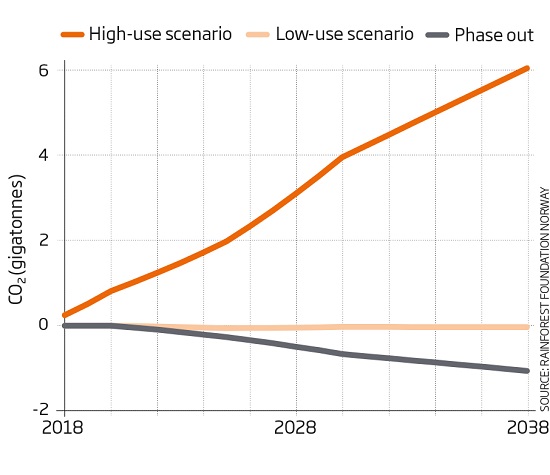Here’s a video first published by Greenpeace in Germany on Facebook. Here’s a screenshot:

An area half the size of Paris, which used to look like this in Irian Jaya, the Indonesian province once known as West Papua:

A New Scientist article by Michael Le Page tells us, it’s not just for food, it is also for the cars of Europe:
-
Under European rules… 10 per cent of transport energy is supposed to come from renewable sources by 2020. To meet this target, countries are blending biofuels like palm-oil biodiesel with conventional fuels.
Here’s their shock image:

Europe imports 7 million tonnes of palm oil annually, half of which goes to biofuel. Worldwide 65 million tonnes are produced, 20 per cent of which goes to biofuel. This is the foreshadowed high biofuel use scenario:

And here are the implications for CO2 emissions:

Those graphs were adapted from a Norwegian report Driving deforestation.
Palm oil produces five times more oil per hectare than rapeseed. However, it produces much higher CO2 emissions, so it would be better to use five acres of disused agricultural land for rapeseed.
Using palm-oil biodiesel triples emissions versus burning fossil fuels, based on figures compiled for the EU.
- This shocking figure isn’t only from burning the fuel, but also from the burning of rainforests to grow oil palm, which releases lots of carbon. What’s more, there are vast stores of peat under many rainforests, which when drained decompose and can release carbon for decades.
The European parliament has voted to end subsidies for palm-oil biodiesel from 2020, but the vote has no force. It is not clear what is going to happen.
When a food commodity is used for fuel the price of the food rises. There is also the destruction of habitat to be considered, not least the orangutan, which exist in the wild only in Borneo and Sumatra, provinces of Malaysia and Indonesia. These two countries between them produce 90 per cent of the world’s palm oil.
Obviously it would be vastly better for the environment to use electric cars. Indeed solar energy would produce vastly more energy from the same area than palm oil. Photosynthesis is a marvel of nature, but is unbelievably inefficient
Meanwhile Indonesia is already using palm oil to mix with aviation fuel, and has a research program to use more. This could be an even bigger driver of deforestation than biofuels used for road transport.
See also The great EU biomass scam and What can save the majestic rainforests of West Kalimantan?

Next post on the environment and climate change will be more optimistic. Promise.
The last pic illustrates the scale of the works. Even in Indonesia, the cost of clearing then sculpting the landscape thus is huge. The environmental impact statement would be interesting. I suspect that the picture is an Indian project. Meantime India’s own palm oil acreage is declining as imported oils become cheaper. The joys of globalisation.
Brian,
On yesterday’s ABC’s Insiders, link here, Barry Cassidy & Laura Tingle (from time interval 07:49) referred to the proposal for the destruction of 2000 hectares of pristine rain-forest gaining support from federal officials that could threaten the GBR. The segment shows the Sunday Age article headlined Forest clearing reef threat, SMH article online link here. The article includes:
Time to re-read an old post of mine on the production of renewable fuels from renewable power, water, air and/or CO2.
These processes provide transport fuels, fertilizer and hydrocarbons without any need for biofuels. Basically:
1. If you have water and renewable electricity you can produce renewable hydrogen.
2. If you have renewable hydrogen and air you can produce renewable ammonia. Liquid ammonia can be used as a transport fuel. It would be transported at pressures similar to LPG and can be used directly as fuel for internal combustion engines or as a source of fuel for fuel cells. It can also be used as a fertilizer or as a starting point for a range of nitro chemicals. There is nothing new about this technology.
3. If you have renewable hydrogen and CO2 you can produce methanol as well as a whole range of more energy intense hydrocarbon fuels such as diesel and hydrocarbons in general.
We don’t need biofuels.
Ammonia based fuels are the easiest to produce because you don’t have to stuff around getting CO2.
Thanks John D
That information goes quite a way to showing why petroleum and biofuels need not loom so large in our planning.
Geoff M, concerning the Kingvale Station proposal, I gather it was approved in 2014 by the Newman government, but Frydenberg is yet to sign off on it.
I have no set view.
The forest is “mostly eucalypt forest and melaleuca swamplands”, not rainforest. Cape Yorke Peninsula is about the size of Victoria, and off the coast the current population I believe is about 12,000. Greenies cannot bear a single tree to be cut down.
From the article:
The runoff goes into two rivers which are 200 km from the coast. I’d be astonished if significant runoff reached the reef, but:
Against that:
If you look at the third image in the article, I think it shows distinct thickening. I imagine when the Aborigines cared for the land there would have been open forest and food for marsupials.
So I’m not going to join the knee-jerk, shock-horror brigade.
John D I was expecting and hoping you’d say what you did. I think as a species we are too stupid to survive. I’m very disappointed in the Europeans.
John Davidson (Re: MAY 14, 2018 AT 5:39 PM):
Demonstrating that it’s possible to produce petroleum replacement liquid fuels to power a small model of a WW2 Mustang aircraft is one thing. Replacing roughly 82 million barrels of oil equivalent per day is another matter (see US IEA monthly data, link here).
The article you referred to is dated 10 April 2014. What developments have occurred since? Has it been scaled up to something bigger? How big? Can it be realistically scaled up?
What energy is required for the energy that is contained in the liquid fuel produced? This is an EROI problem. There’s nothing in the article that indicates answers to these key questions.
I don’t have the same optimism as you that this tech can be scaled up to be something useful, let alone be available in a timely manner. And the clock’s ticking for both climate change and a post- ‘peak oil’ world.